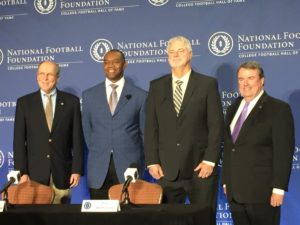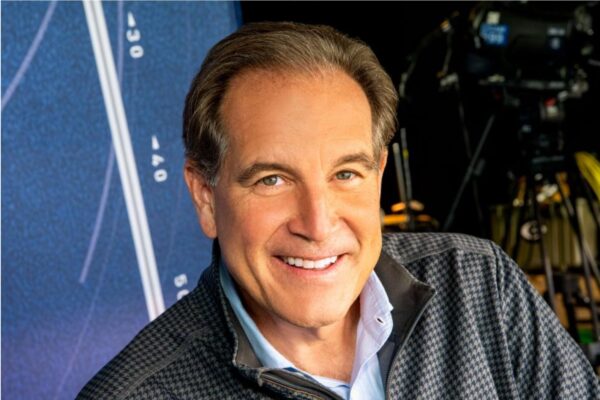
(Left to right) College Football Playoff Executive Director Bill Hancock, former UNLV quarterback and punter Randall Cunningham, former Harvard tight end and punter Pat McInally, and National Football Foundation President and CEO Steve Hatchell at the College Football Hall of Fame announcement on Jan. 8 in Scottsdale, Arizona.
By Frank Gogola | @FrankGogola
Sports Capital Journalism Program
SCOTTSDALE, Ariz. — Former Florida State linebacker Derrick Brooks remembered being called into head coach Bobby Bowden’s office during his freshman season. He dreaded it because he knew players were only called into the coach’s office when something bad happened.
Brooks had just earned his first C during his freshman year in Tallahassee, and Bowden expressed his disappointment in Brooks, an A and B-student in high school.
“He shared with me how his expectations of me was to not only lead our football team on the field, but [to] set a standard for our football program off the field when it came to academics,” Brooks said via telephone during Friday’s announcement of the 2016 College Football Hall of Fame class. “To me, that was the importance of [being a] student-athlete and how I needed to be an example of what that student-athlete would be at Florida State University to my team.”
Striving to become that leader, Brooks became a 1994 National Football Foundation National Scholar-Athlete. He also thrived on the field as a two-time unanimous First Team All-American and a three-time First Team All-Atlantic Coast Conference player.
Additionally, Brooks was the FWAA’s Defensive Player of the Year in 1993 and 1994, his junior and senior seasons, and was the 1994 ACC Player of the Year. He helped lead the Seminoles to the program’s first-ever national championship in 1993. His No. 10 jersey was retired by Florida State in 2010.

Additional information on the 2016 College Football Hall of Fame class cane be found here.
Friday, Brooks, 42, was one of 14 players and two coaches who were announced as inductees into the College Football Hall of Fame. He was one of four players who spoke in person or over the phone during the announcement, which was made Friday as part of the College Football Playoff weekend festivities.
This was the second year the announcement of the Hall of Fame class was made during national championship weekend. Bill Hancock, executive director of the College Football Playoff, said kicking off the weekend with the Hall of Fame announcement was a way to “synergize” the two events. NFF Chairman Archie Manning said the championship game attracts such a large number of national media that the timing of the announcement “greatly enhances our ability to provide the media access to our game’s greatest icons.”
Only 977 players out of 5.06 million individuals who have played college football since 1869 have earned the sport’s ultimate honor. Only 211 coaches have been inducted into the College Football Hall of Fame.
A player must have been a First Team All-American to be eligible for nomination. He must have played within the last 50 years, must be at least 10 years removed from playing college football, and cannot be an active professional player.
A coach must have been a head coach for at least 10 years and 100 games, won 60 percent or more of his games and be retired for at least three years. There is no waiting period for retired coaches over 70 years old, while a coach over 75 is eligible as an active coach.
A coach must have been a head coach for at least 10 years and 100 games, won 60 percent or more of his games and be retired for at least three years. There is no waiting period for retired coaches over 70 years old, while a coach over 75 is eligible as an active coach.
Pat McInally, a former Harvard tight end and punter in the 2016 Hall of Fame class, also spoke of how academics and football intertwined for him. His mom pushed academics while his dad pushed athletics. His goal was to combine the two and go to Harvard and be an All-American.
“My parents always thought that was the most bizarre goal,” McInally said. “I wanted to show you can have an education and you can excel in football of all sports.”
McInally was a First Team All-American and NFF Scholar-Athlete in 1974. Now a coach at Brethren Christian High School in Huntington Beach, California, McInally, preaches the importance of academics to his players. He said that “football opens doors for kids” who might not be the most gifted students to get a quality college education. “Academically, that’s what’s really important,” he said.
Former UNLV punter and quarterback Randall Cunningham and former Purdue defensive back Rod Woodson were among the other inductees to participate in the announcement.
Cunningham, the first UNLV Rebel in the College Football Hall of Fame, said his main goal was to make it to the NFL but called the announcement of his induction the “icing on the cake.” He added: “This is the greatest thing that’s happened to me in sports.”
Cunningham earned First Team All-American honors as a punter in 1983. In 1984 he was named a Second Team All-American as a punter and an Honorable Mention as a quarterback. He could only be inducted as a punter since he didn’t make a first team as a quarterback.
Cunningham thanked former coaches for the impact they had on his life. Now a coach at Silverado High School in Las Vegas, he can give back just like his coaches had: “To be able to go back and pour it into the system makes a big difference.”
Cunningham said he always liked and emulated Joe Namath, Doug Williams and James Harris. But, it was his brother, Sam “Bam” Cunningham, a 2010 College Football Hall of Fame inductee, who inspired him the most to play football.
“These people really influenced me, made me work hard,” Cunningham said. “I wanted to be like them. I wanted to wear the same jersey numbers. Wanted to have the same character, mentality, integrity and morals.”
Woodson similarly thanked his previous coaches for bringing him into the Boilermaker family, allowing him to make mistakes and forgiving him when he did make a mistake.
“It made me feel comfortable,” Woodson said. “It kind of made me feel like I was at home. And I think with that, I wanted to give back to them by performing at my best on the athletic field.”
Woodson did just that. He was a 1986 consensus First Team All-American and a three-time First Team All-Big Ten player. He holds 13 school records, including interceptions.
“To think a young kid from Fort Wayne, Indiana, who went to Snider High School and Purdue University, [could] be inducted into the College Football Hall of Fame is just an accomplishment and an honor that I’ll cherish forever,” Woodson said.
The 2016 class will participate in pregame festivities and the coin toss at the College Football Playoff National Championship presented by AT&T at 8:30 p.m. ET on Jan. 11 at University of Phoenix Stadium in Glendale, Arizona. They will be formally inducted into the College Football Hall of Fame at the NFF 59th Annual Awards Dinner on Dec. 6 at the Waldorf Astoria in New York City.


